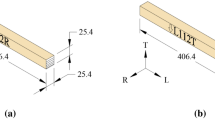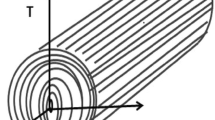Abstract
The relationship between stress wave nondestructive (NDE) modulus of elasticity (MOE) and static MOE determined by four point bending test of commercial wood-plastic composites was evaluated in this study to assess the potential of using the NDE technique as a grading tool for wood plastics as it is currently done for solid lumber. The NDE MOE was evaluated on a Metriguard Model 340 E computer system, and the static MOE of the same boards measured on an Instron Universal Tester model 5587 according to the ASTM standard D 6109. Results showed that the NDE MOE values overestimated the static MOE from 3.5% to 17.6% depending on the boardwalk type. Regression analysis showed no significant correlation between the NDE MOE and the Static MOE. These results suggest that the stress wave NDE technique may not be appropriate to estimate the static MOE of wood plastic lumber. The trend however needs to be confirmed by further testing using a larger sample size and different combination of the raw materials.
Zusammenfassung
In dieser Studie wurde die Beziehung zwischen dem über Biegeschwingung ermittelten, zerstörungsfreien, dynamischen E-Modul (NDE MOE) und dem mittels Vier-Punkt-Biegeversuch bestimmten, statischen E-Modul von gebräuchlichen Holz-Kunststoff-Verbundwerkstoffen untersucht, um die Eignung dieser bei Vollholz angewandten zerstörungsfreien Prüfmethode als Sortierverfahren für Holz-Kunststoff-Verbundwerkstoffe festzustellen. Der dynamische E-Modul wurde mit einem Metriguard Model 340 E Computersystem bestimmt. Der statische MOE wurde an den gleichen Brettern mittels einer Instron Prüfmaschine Model 5587 nach der ASTM Norm D 6109 ermittelt. Die Ergebnisse zeigten, dass, je nach Bretttyp, der dynamische E-Modul um 3.5 bis 17.6% höher lag als der statische E-Modul.
Regressionsanalyse ergab keine eindeutige Korrelation zwischen den beiden E-Modulen. Diese Ergebnisse deuten darauf hin, dass sich das Biegeschwingungsverfahren zur Bestimmung des statischen E-Moduls von Holz-Kunststoff-Verbundplatten nicht eignen könnte. Dieser Zusammenhang bedarf jedoch noch weiterer Untersuchungen an grösseren Proben aus verschiedenen Rohmaterialien.
Similar content being viewed by others
References
American Society for Testing and Materials (ASTM) (1999) Standard Test Methods for Flexural Properties of Unreinforced and Reinforced Plastic Lumber (Deck Board Structural Testing for PVC). ASTM D6109, West Conshohocken, PA
Cai Z, Hunt MO, Ross RJ, Soltis LA (2000) Static Vibration Moduli of Elasticity of Salvaged and New Joist. Forest Prod J 50(2):35–40
Erikson RG, Gorman TM, Green DW, Graham D (2000) Mechanical Grading of Lumber Sawn from Small-Diameter Lodgepole Pine, Ponderosa Pine, and Grand Fir Trees from Northern Ohio. Forest Prod J 50(7/8):59–65
Govindarajoo R, Pellerin RF, Ross RJ (1994) Localized Modulus of Elasticity Properties of E-rated Spruce-Pine Laminating Lumber. Forest Prod J 44(4):25–32
Kollmann FFP, Côte WA (1984) Principles of Wood Science and Technology. Vol I, Solid Wood. Springer-Verlag, New York, p 592
Ross RJ, Pellerin RF (1991) NDE of Green Material with Stress Waves: Preliminary Results Using Dimension Lumber. Forest Prod J 41(6):57–59
Ross RJ, Ward JC, TenWolde A (1994) Stress Wave Nondestructive Evaluation of Wetwood. Forest Prod J 44(7):79–83
Ross JR, Fuller JJ, Dramm JR (1995) Nondestructive Evaluation of Green Defect-Prone Red Oak Lumber: A Pilot Study. Forest Prod J 45(11–12):51–52
Ross RJ, Yang VW, Illman BL, Nelson WJ (2003) Relationship Between Stress Wave Transmission Time and Bending Strength of Deteriorated Oriented Strandboard. Forest Prod J 53(3):33–35
Soltis LA, Wang X, Ross RJ, Hunt MO (2002) Vibration Testing of Timber Floor Systems. Forest Prod J 52(10):75–81
Wang X, Ross RJ, Erikson JR, Forsman JW, McGinnis GD, DeGroot RC (2001) Nondestructive Evaluation of Potential Quality of Creosote Treated Piles Removed From Service. Forest Prod J 51(2):63–68
Author information
Authors and Affiliations
Corresponding author
Rights and permissions
About this article
Cite this article
Nzokou, P., Freed, J. & Kamdem, D. Relationship between non destructive and static modulus of elasticity of commercial wood plastic composites. Holz Roh Werkst 64, 90–93 (2006). https://doi.org/10.1007/s00107-005-0080-x
Published:
Issue Date:
DOI: https://doi.org/10.1007/s00107-005-0080-x




